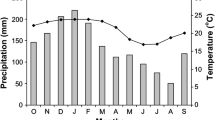Abstract
We studied the spatial distribution of fruits and plants, mortality and growth rates ofScaphium macropodum (Sterculiaceae) in four 1-ha plots in a tropical rain forest in West Kalimantan, Indonesia. The species is a large deciduous tree and produces wind-dispersed fruits on defoliated twigs. The density of dispersed fruits on the ground decreased with increasing distance from a parent tree. The area under the parent's crown had the highest density of the fruits and the highest mortality of the seedlings immediately after germination. Consequently, the density of the established seedlings peaked 14 m from the tree which is outside its crown. Thick litter mainly from the parent tree seemed to physically prevent the seedlings' root from reaching the soil surface and caused the high mortality. Juvenile and mature trees distributed exclusively, suggesting that regeneration is the most successful outside of the crown of mature trees. Saplings under canopy shade did not grow well.Scaphium macropodum is hypothesized to require a gap for seedling growth and successful regeneration, whereas it can germinate and last under closed canopies as suppressed seedlings or saplings.
Similar content being viewed by others
References
Augspurger, C.K. 1983. Seed dispersal of the tropical tree,Platypodium elegans, and the escape of its seedlings from fungal pathogens. J. Ecol.71: 759–771.
Burkey, T.V. 1994. Tropical tree species diversity: a test of the Janzen-Connell model. Oecologia97: 533–540.
Canham, C.D. 1985. Suppression and release during canopy recruitment inAcer saccharum. Bull. Torrey Bot. Club112: 134–145.
Clark, D.A. andClark, D.B. 1984. Spacing dynamics of a tropical rain forest tree: evaluation of the Janzen-Connell model. Am. Nat.124: 769–788.
Condit, R., Hubbell, S.P. andFoster, R.B. 1992. Recruitment near conspecific adults and the maintenance of tee and shrub diversity in a neotropical forest. Am. Nat.140: 261–286.
Connell, J.H. 1971. On the role of natural enemies in preventing competitive exclusion in some marine animals and in rain forest trees.In P.J. Boer and G.R. Gradwell, eds., Dynamics of Population. Center for Agricultural Publishing and Documentation, Wageningen. pp. 361–381.
Hamric, J.L. andLee, J.M. 1987. Effect of soil surface topography and litter cover on the germination, survival, and growth of musk thistle (Carduus nutans). Amer. J. Bot.74: 451–457.
Hubbell, S.P. 1979. Tree dispersion, abundance, and diversity in a tropical dry forest. Science203: 1299–1309.
Hubbell, S.P. andFoster, R.B. 1986. Commonness and rarity in a neotropical forest: implications for tropical tree conservation.In M.E. Soule, ed., Conservation Biology: The Science Scarcity and Diversity. Sinauer, Sunderland, Massachusetts, USA. pp. 205–231.
Itoh, A. 1995. Effects of forest floor environment on germination and seedling establishment of two Bornean rain forest emergent species. Journal of Tropical Ecology11: 517–527.
Iwao, S. 1972. Application of the m*−m method to the analysis of spatial patterns by changing the quadrat size. Res. Popul. Ecol.14: 97–128.
Iwao, S. 1977. Analysis of spatial association between two species based on the interspecies mean crowding. Res. Popul. Ecol.18: 243–260.
Janzen, D.H. 1967. Synchronization of sexual reproduction of trees within the dry season in central America. Evolution21: 620–625.
janzen, D.H. 1970. Herbivores and the number of tree species in tropical forests. Am. Nat.104: 501–528.
Janzen, D.H. 1972. Escape in space bySterculia apetala seeds from the bugDysdercus fasciatus in a Costa Rican deciduous forest. Ecology53: 351–361.
Kitajima, K. andAugspurger, C.K. 1989. Seed and seedling ecology of a monocarpic tropical tree,Tachigalia versicolor. Ecology70: 1102–1114.
Kochummen, K.M. 1972. Sterculiaceae.In T.C. Whitmore, ed., Tree Flora of Malaya vol. 2, Longman, Kuala Lumpur. pp. 353–382.
Kohyama, T., Suzuki, E. andHotta, M. 1994. Spatial distribution pattern of representative tree species in a foothill rain forest in West Sumatra. Tropics4: 1–15.
Kostermans, A.J.G.H. 1953. The generaScaphium Schott & Endl. andHildegrdia Schott & Endl. (Sterculiaceae). Journal for Scientific Research in Indonesia2: 13–23.
Masaki, T., Suzuki, W., Niiyama, K., Iida, S., Tanaka, H. andNakashizuka, T. 1992. Community structure of a species-rich temperate forest, Ogawa Forest Reserve, Central Japan. Vegetatio,98: 97–111.
Molofsky, J. andAugspurger, C.K. 1992. The effect of leaf litter on early seedling establishment in a tropical forest. Ecology73: 817–826.
Morisita, M. 1959. Measuring of the distribution of individual and analysis of the distribution patterns. Mem. Fac. Sci. Kyushu Univ., Ser. E (Biol),2: 215–235.
Ridley, H.N. 1930. Dispersal of Plants Throughout the World. L. Reeve, Kent.
Schupp, E.W. 1992. The Janzen-Connell model for tropical tree diversity: population implications and the importance of spatial scale. Am. Nat.140: 526–530.
Steven, D.D. 1994. Tropical tree seedling dynamics-recruitment patterns and their population consequences for three canopy species in Panama.Journal of Tropical Ecology 10: 369–383.
Suzuki, E. andKohyama, T. 1991. Spatial distributions of wind-dispersed fruits and trees ofSwintonia schwenkii (Anacardiaceae) in a tropical forest of West Sumatra. Tropics1: 131–142.
Yamada, T. andSuzuki, E. 1996. Ontogenic change in leaf shape and crown form of a tropical tree species,Scaphium macropodum in Borneo. J. Plant Res.109: 211–217.
Yoda, K. 1974. Three-dimensional distribution of light intensity in a tropical rain forest in West Malaysia. Jap. J. Ecol.24: 247–254.
Author information
Authors and Affiliations
Rights and permissions
About this article
Cite this article
Yamada, T., Suzuki, E. Changes in spatial distribution during the life history of a tropical tree,Scaphium macropodum (Sterculiaceae) in borneo. J. Plant Res. 110, 179–186 (1997). https://doi.org/10.1007/BF02509306
Received:
Accepted:
Issue Date:
DOI: https://doi.org/10.1007/BF02509306




